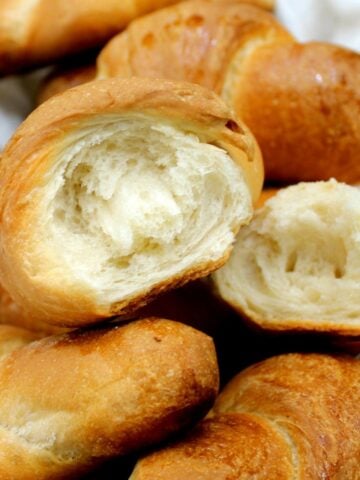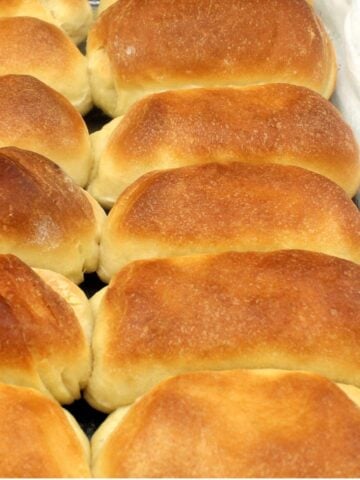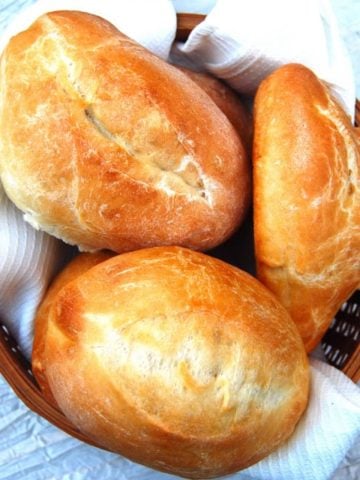Indian cuisine is most often associated with flatbreads like roti, naan and paratha. But in former Portuguese colonies like Bombay and Goa, a humble dinner roll, pav, took a firm foothold and has remained firmly entrenched in the local food scene over the centuries. You can buy pav in western Indian bakeries, but this simple bread roll is easy enough to make at home. In Goa, a street vendor called a poder (derived from the Portuguese word for baker, padeiro) still makes the round of neighborhoods every morning, a big basket of pav balanced on his bicycle, honking the horn to alert residents that breakfast is here!
What is pav?
Pav (also spelled “pao”), is a soft, yeasted Indian bread roll. This is a very basic bread, made with just yeast, flour and water or milk. It is also eggless - a nod to the many Indian vegetarians who do not eat eggs. Pav is often called “laadi pav,” with laadi being the Marathi word for slab. That’s because the pav is usually sold in slabs or four, six, eight, 10 or 12. There are two types of pav: a soft pav, like this one, and a pav with a harder crust called “brun pav” or “kadak pav.” The only difference between the two is that the latter is baked in a steamy oven to create a crustier crust (like a baguette). If you ever happen to be in Bombay, visit one of its charming but dwindling Irani restaurants and order a plate of “brun maska” made by slashing the crusty roll in half and slathering it with butter and jam: it’s a rare and delicious treat.
A dairy-free pav recipe
In bakeries, pav is typically made with just flour, water and yeast. But to get the correct texture in a home kitchen, milk is added to the recipe. The milk helps make the rolls softer and fluffier. For this vegan pao recipe soy milk works wonderfully. I shared this pav recipe many, many years ago in my pav bhaji recipe, and I’ve continued to make it over the years without many tweaks because it’s quite perfect as it is. The only variation I do make is to sometimes use whole grain flour (more on that below).
How to make pav
Healthier variations
Part whole-wheat pav: Use a 50:50 proportion of all-purpose flour and whole wheat flour. It creates a nuttier-tasting, more dense but fluffy pav that’s also healthier. All-whole-wheat pav: You can make a really good all-whole-wheat pav by subbing the all-purpose flour with whole wheat flour. But replace 1 tablespoon of the flour with vital wheat gluten for a soft texture and good rise.
Store
The pav can be stored at room temperature for a day, and refrigerated or frozen for longer storage. Store in the fridge in an airtight bag or container for up to a week. Freeze in a freezer-safe bag for up to four months. Thaw and warm the bread in a 350 degree F/180 degree C oven until heated through and soft again.
All-purpose flour. Unbleached all-purpose flour keeps these pav rolls as authentic as possible. If you are looking for a healthier alternative, I have some options below. Active dry yeast or instant yeast. Either works in this pav recipe. If you are using active dry yeast it’s a good idea to make sure it’s alive and well and will work for you. You can do this by mixing the yeast and the warm milk first and waiting for the yeast to bubble before you add the dry ingredients. Soy milk. I like a non-dairy milk with a high protein content for a better texture to the rolls. If you are allergic to soy, use any other non-dairy milk. Sugar. The sugar helps feed the yeast and gives the dough a better rise. Oil. Use any neutral oil. You can also use softened vegan butter at room temperature.
Check to get new recipe updates by email.
Or do it like the Irani restaurants do and serve it as a snack: cut a roll across, daub on a good amount of vegan butter, and top it with jam. Yum!
Recipe card
More delicious bread rolls













